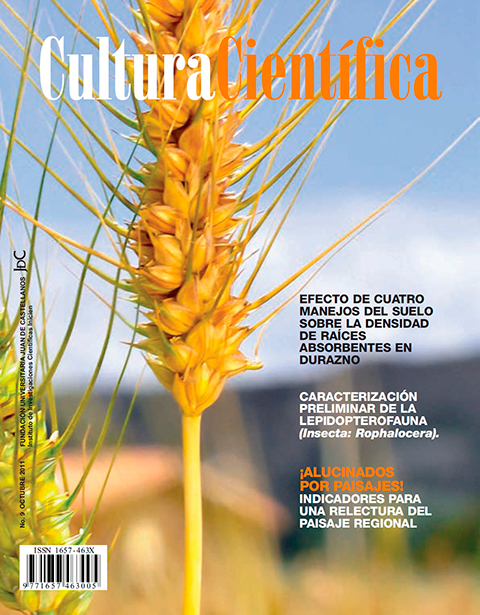Keywords:
additive, food choice, poultry, feed conversion.Abstract
In Colombia since 1984, allows the use of antibiotic growth promoters (APC) as a mechanism to improve the productive performance of poultry. but the use of subtherapeutic levels APC favors the development of antibiotic resistance factors, causing a public health problem, by the emergence of resistant bacteria. However, the use of vegetable extracts emerges as an alternative phytogenetic to the use of APC. The extract of oregano has been commonly used for its antioxidant and bacteriostatic action allowing the improvement of productive performance of broilers. The aim of this study was to evaluate the effect of the addition of fresh leaves of oregano (O. vulgare) on weight gain, efficiency and feed conversion in Cobb broilers. For this purpose we performed a study with a randomized experimental model and duration of 32 days, 8 of which were a period of adaptation to the oregano leaves feeding. Three treatments were used, each with 30 chicks of the Cobb line with independent registers and fed a commercial concentrate. The T3 is called control; the T1 and T2 were added to the commercial diet 1 and 5% respectively of fresh oregano leaves. It is observed that there is no statistically significant difference (p≥0.05) for weight gain, but if, there are statistically significant differences in the efficiency and feed conversion (p≤ 0.05) with respect to the control treatment (T3). Suggesting, that the addition of fresh leaves of oregano can improve production efficiency in poultry.Downloads
References
Acosta, L. 1995. Proporciónese salud: Cultive plantas medicinales. Editorial Científico Técnica Ciudad Habana: 71-73
Aligiannis, N. et al. 2001. Composition and antimicrobial activity of the essential oils of two Origanum species. J. Agric. Food Chem. 49, 4168-4170.
Ayala, L. et al. 2006. A note the effect of oregano as additive on the productive performance of broilers. Cuban Journal of Agriculture Science. 40, 437-440.
Calsamiglia, S. et al. 2006. Alternatives to Antimicrobial Growth Promoters in Cattle. En: Recent Advances in Animal Nutrition, Garnsworthy, P.C. and J. Wiseman (Eds.). Nottingham University Press, Nottingham, UK Pp 107-134.
Carro, M. y Ranilla, M. 2002. Aditivos antibióticos promotores del crecimiento de los animales: Situación actual y posibles alternativas. Departamento de Producción Animal I. En: Sitio Argentino de producción animal, http://www.produccionanimal.com.ar/informacion_tecnica/invernada_promotores_crecimiento. Consulta mayo 2011.
Castro, M. 2005. Uso de aditivos en la alimentación de los animales monogástricos. Revista Cubana de Ciencia Agrícola. 39, 451-457.
Dorman, H. y Deans, S. 2000. Antimicrobial agents from plants: antibacterial activity of plant volatile oils. J Appl Microbiol 88, 308-316.
Fukayama, E. et al. 2005. Extrato de orégano como aditivo em rações para frangos de corte. Revista da Sociedade Brasileira de Zootecnia 2005; 34(6):2316-2326.
Hernández, F. et al. 2004. Influence of two plant extracts on broilers performance, digestibility, and digestive organ size. Poultry Sci 83, 169-174.
Isabel, B. y Santos, Y. 2009. Efectos de los aceites esenciales en la alimentación de pollos de carne. Arch. Zootec. 58 (supl 1), 597-600.
Kiser, J. 2007. A perspective on the use of antibiotics in animal feeds. Journal of Animal Science. 42, 1058-1072.
Lozano, C. et al. 2004. El orégano: propiedades, composición y actividad biológica de sus componentes. Archivos latinoamericanos de Nutriciòn. Vol 54.
Marcinčák, S. et al. 2008. Antioxidative effect of oregano supplemented to broilers on oxidative stability of poultry meat. Slov Vet Res 45, 6.
Méndez, A. et al. 2008. Evaluación del efecto del extracto de orégano (Oreganum vulgare) sobre algunos parámetros productivos de cerdos destetos Revista Tumbaga 1, 3.
Plaus, E. et al. 2001. Composición química y actividad antibacteriana del aceite esencial del Origanum vulgare (orégano). Revista Médica Herediana, 12, 16-19.
Ultee, A. el al. 2002. The phenolic hydroxyl group of carvacrol is essential for action against the food-borne pathogen Bacillus cereus. Appl. Environ. Microbiol. 68:1561–1568.
Aligiannis, N. et al. 2001. Composition and antimicrobial activity of the essential oils of two Origanum species. J. Agric. Food Chem. 49, 4168-4170.
Ayala, L. et al. 2006. A note the effect of oregano as additive on the productive performance of broilers. Cuban Journal of Agriculture Science. 40, 437-440.
Calsamiglia, S. et al. 2006. Alternatives to Antimicrobial Growth Promoters in Cattle. En: Recent Advances in Animal Nutrition, Garnsworthy, P.C. and J. Wiseman (Eds.). Nottingham University Press, Nottingham, UK Pp 107-134.
Carro, M. y Ranilla, M. 2002. Aditivos antibióticos promotores del crecimiento de los animales: Situación actual y posibles alternativas. Departamento de Producción Animal I. En: Sitio Argentino de producción animal, http://www.produccionanimal.com.ar/informacion_tecnica/invernada_promotores_crecimiento. Consulta mayo 2011.
Castro, M. 2005. Uso de aditivos en la alimentación de los animales monogástricos. Revista Cubana de Ciencia Agrícola. 39, 451-457.
Dorman, H. y Deans, S. 2000. Antimicrobial agents from plants: antibacterial activity of plant volatile oils. J Appl Microbiol 88, 308-316.
Fukayama, E. et al. 2005. Extrato de orégano como aditivo em rações para frangos de corte. Revista da Sociedade Brasileira de Zootecnia 2005; 34(6):2316-2326.
Hernández, F. et al. 2004. Influence of two plant extracts on broilers performance, digestibility, and digestive organ size. Poultry Sci 83, 169-174.
Isabel, B. y Santos, Y. 2009. Efectos de los aceites esenciales en la alimentación de pollos de carne. Arch. Zootec. 58 (supl 1), 597-600.
Kiser, J. 2007. A perspective on the use of antibiotics in animal feeds. Journal of Animal Science. 42, 1058-1072.
Lozano, C. et al. 2004. El orégano: propiedades, composición y actividad biológica de sus componentes. Archivos latinoamericanos de Nutriciòn. Vol 54.
Marcinčák, S. et al. 2008. Antioxidative effect of oregano supplemented to broilers on oxidative stability of poultry meat. Slov Vet Res 45, 6.
Méndez, A. et al. 2008. Evaluación del efecto del extracto de orégano (Oreganum vulgare) sobre algunos parámetros productivos de cerdos destetos Revista Tumbaga 1, 3.
Plaus, E. et al. 2001. Composición química y actividad antibacteriana del aceite esencial del Origanum vulgare (orégano). Revista Médica Herediana, 12, 16-19.
Ultee, A. el al. 2002. The phenolic hydroxyl group of carvacrol is essential for action against the food-borne pathogen Bacillus cereus. Appl. Environ. Microbiol. 68:1561–1568.
Downloads
Published
2011-10-24
How to Cite
Jiménez, A., & González Torres, Y. O. (2011). Effect of the addition of fresh leaf oregano (Origanum vulgare) production performance of broilers. Cultura científica, (9), 36–40. Retrieved from https://revista.jdc.edu.co/Cult_cient/article/view/215
Issue
Section
Article of scientific and technological research





